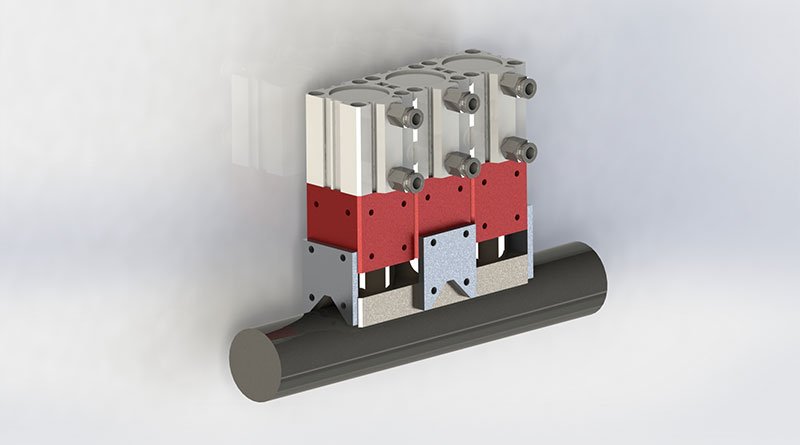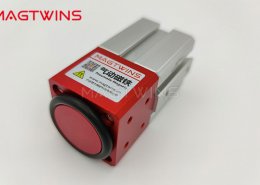Factors that affect the pneumatic magnets gripping capacity
There are 6 factors that affect magnetic gripper capacity. Material, Air gaps, Surface finish condition, Robot rotation angles, Temperature, Parts thickness.
Material
The material in which the magnetic gripper is attracting to will affect its performance. When magnets are tested to identify their pull strength, a mild steel is used as the contact steel.
Mild steel is preferred to alloy steels and cast irons is the ability to conduct magnetism is far higher.
Alloy steels and cast irons have a reduced ability to conduct magnetism which therefore reduces the pull of a magnet and it will not perform at its maximum capability.
Cast iron in particular can reduce the pull of a magnet by as much as 40% due to the fact that cast iron is much less permeable than mild steel.
Materials such as Copper and Zinc are not magnetic, and as such are commonly used as coatings for magnets.
Some non ferrous material like stainless steel and aluminium could not handling by magnetic grippers.
Air Gaps
Air gaps will also reduce the performance and capacity of a magnetic gripper. An air gap refers to any non-magnetic material that prevent magnetism from attracting to another magnet or ferrous object.
Air gaps can occur if the contact steel is rusty, dirty, painted or uneven for any reason, which will cause a loss in magnetism.
As a magnet produces a magnetic circuit, any air gap will cause a break in this and subsequently means that magnetism has to ‘jump’ from the magnet to the other magnet or ferrous object to continue the circuit.
The bigger the air gap, the bigger the reduction in the magnets pull and performance.
Surface finish condition
Ground surface will have a full contact between the magnetic gripper and lifted parts. While rough cast parts might not have a enough contact are with the magnets and loss gripping strength.
Robot rotation angles
Magnet gripper can be fixed within a horizontal or vertical position which is dependant on the application. When magnets are fixed in a vertical position(handling direction same with gravity), this is known as the sheer position.
It is five times easier to slide a magnetic gripper than to pull it away from the surface it is attracting to. This is due to the coefficient of friction which is typically 0.2 for steel on steel surfaces.
If you were to apply a magnetic gripper to a steel surface that has a pull strength of 10kg in a sheer (vertical) position, the magnetic gripper will only support 2kg – this should be considered when looking to use a gripper magnet in a sheer position, and the weight of the item being loaded on to the magnet must be considered when assessing the pull strength required from the magnet.
If the load is heavier than the magnets sheer position pull, the magnet will begin to slide down the steel surface. That’s why the robot gripper magnet should count much more safety factor when choose the capacity if both horizontal and vertical lifting exist.
TEMPERATURE
Subjecting a magnet to temperatures above its maximum operating temperature will cause it to lose performance, which won’t be recovered on cooling.
Repeatedly heating beyond the maximum operating temperature will result in a significant decrease in performance.
This is due to the magnetic domains within the magnet becoming miss-aligned, which will in turn cause the magnet to lose its magnetism.
In contrast to this, when a magnet is continuously exposed to low temperatures, the strength increases due to its magnetic properties being enhanced.
Neodymium(NdFeB) max operation temp could up to 80 degree C, while ferrite magnet is 180 degree C, samarium cobalt magnet is 350 degree C, Alnoco magnet could up to 525 degree C.
Normally the magnetic gripper will use NdFeB magnets inside as force source, if the customer working temperature is higher than 80 degree C, we may need to use high temperature resistance magnets.
Parts THICKNESS
The thickness of a steel surface a gripper magnet is attracting to can impact the performance and pull of a gripper magnet.
If a gripper magnet requires the contact steel to be 10mm thick in order to absorb all the magnetism and ensure for maximum performance and pull, then applying the gripper magnet to a 1mm thick steel surface will result in the gripper magnet losing 90% of its magnetism and therefore only delivering 10% of its maximum capability.
It is therefore important to ensure that a gripper magnet is attracting to the surface with its full performance and no stray magnetism is leaving the steel.
A way to test and ensure no magnetism is lost is by fixing the gripper magnet in place on the steel surface, and then applying a small steel plate behind the contact steel. If the small plate remains attracted behind the contact steel, then the magnetism is not being fully absorbed by the contact steel which indicates that the thickness of the steel is insufficient.
Alternatively, if the small steel plate falls away from behind the contact steel, then the steel is fully absorbing all magnetism, ensuring the magnet is providing its maximum pull and performance. Applying thicker steel will not increase the pull of the gripper magnet.













